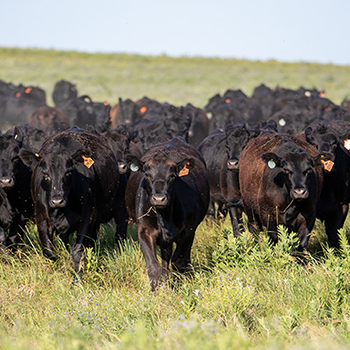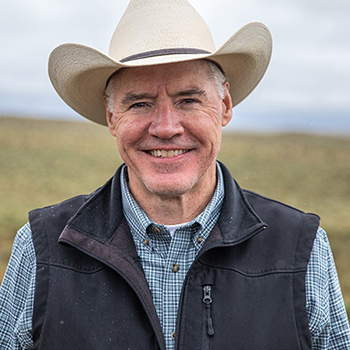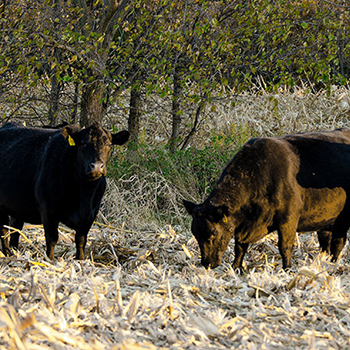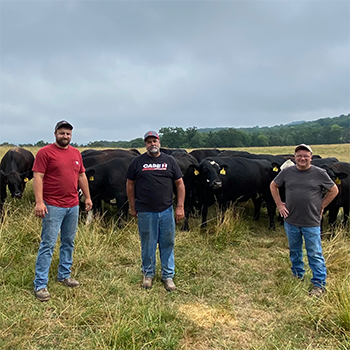Gizmos & Gadgets
Products for use on farms, ranches and feedlots.
This month’s new product features include FDA approval for combined use in feeding cattle, a forage inoculant, a new line of center-pivot disc mower-conditioners, a line of self-propelled forage harvesters, and the agriculture industry’s first autonomous spreader.
FDA approves combination use of two key medications for cattle feeding
For years, cattle producers have been looking for the benefits of therapeutic applications of chlortetracycline combined with the coccidiosis control and performance results of Rumensin® for receiving/starter rations. Until now, they’ve had to choose one or the other. In late July, the Food and Drug Administration (FDA) approved the combination use of Pennchlor® (chlortetracycline Type A medicated article) and Rumensin (monensin Type A medicated article) in beef calves 2 months of age and older, and growing beef steers and heifers fed in confinement for slaughter. At a time when input costs, including feed, are at an all-time high, the ability to use these products in combination gives producers more options to improve the sustainability and efficiency of their business.
Contact your Elanco or Pharmgate representative for additional information, or contact your cattle nutritionist. To access labeling or other forms go to https://www.pharmgate.com/usa/.
New forage inoculant allows feedout flexibility, maximizes dry-matter and nutrient retention in feed
Lallemand Animal Nutrition announces the launch of its newest product in the line of Magniva Forage Inoculants — Magniva Platinum. For U.S. producers, Platinum is the next step in the product line, complete with three unique bacterial strains: Pediococcus pentosaceus NCIMB 12455, Lactobacillus buchneri NCIMB 40788 and Lactobacillus hilgardii CNCM I-4785 — and an enzyme package. In combination, these strains have been proven to maximize dry matter, nutrient retention, feed digestibility and aerobic stability.

|
“The difference in Magniva Platinum lies in the addition of the newly patented lactic acid bacterium L. hilgardii CNCM I-4785,” says Renato Schmidt, technical services, forage, at Lallemand Animal Nutrition. “L. hilgardii CNCM I-4785 works in combination with the other strains and the enzyme package to improve stability of the silage faster, as well as maintain stability for longer-stored silages.”
The new inoculant puts producers in control of their silages more than ever before. The combination strains work together to provide dominant fermentation and improve aerobic stability in a shorter time frame, offering more feedout flexibility. This means producers can open their silage in just 15 days, helping manage long-term feed costs and increase profitability.
“We have extensive data from the University of Delaware, University of Florida, the Lallemand Center of Excellence in Chazy, New York, and the Lethbridge Research Centre,” says Schmidt. “The data from the University of Delaware shows us that Magniva Platinum, at the recommended rate for high moisture corn (HMC, applied at 1.5 rate), led to improvements in fermentation characteristics and aerobic stability compared to untreated HMC after 15-day and 130-day fermentations.”
Lallemand’s forage inoculants have been on the U.S. market for more than 20 years. In that time, they’ve been proven to deliver consistently high-quality silage year after year.
“Ensiled forages represent a vital, but increasingly more expensive portion of rations for dairy and beef cattle,” says Schmidt. “The quality of the silage directly impacts animal nutrition and well-being, which is where Magniva Forage Inoculants come in. With the addition of Magniva, producers can control both the fermentation and quality of their forage, as well as enhance the overall value at feedout.”
To learn more, visit magniva.lallemandanimalnutrition.com/en/northamerica.
New lineup of center-pivot disc mower-conditioners
New Holland Agriculture North America is redefining the disc mower-conditioner with the introduction of the Discbine® Plus Series. For modern hay producers, New Holland understands they need equipment that improves their productivity and optimizes their quality to preserve valuable feed nutrients. That’s exactly what New Holland designed the Discbine Plus Series to help customers do.
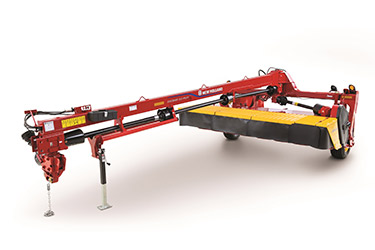
New Holland launches all-new lineup of Discbine PLUS Series center-pivot disc mower-conditioners |
“A disc mower-conditioner isn’t a genuine Discbine unless it’s built and backed by the best in the business. From the hitch to the swath doors, these four models are designed and built with pride in New Holland, Pennsylvania,” says Sally Johnson, vice president for New Holland Agriculture North America.
“The Discbine Plus models have bold, new styling and yellow accents to signify commercial-grade performance. They’re built with the same DNA, durability and superior quality that customers know and expect, but we’ve focused on enhanced cutting and swath controls for greater overall performance,” says Jordan Milewski, conventional haytools marketing manager for New Holland Agriculture North America.
These machines include a maneuverable center-pivot tongue and standard swivel gearbox hitch that permit confident, fast operation; and easy, trouble-free headland turns.
All Discbine Plus models utilize the MowMax™ II PLUS disc cutter bar with the QuickMax™ knife-change system. This newly redesigned cutter bar delivers the cleanest cut yet from New Holland and commercial durability. It is similar to the cutter bar featured on Durabine™ Plus disc headers for Speedrower® Plus self-propelled windrowers.
Delivering a faster tip speed, the cutter bar comes equipped with longer knives. This slimmer cutter bar improves cut quality, while a 30% lower cutting height leaves less behind in down and tangled crops. For cleaner cutting in light or late-season crops, the reshaped rock guards enhance crop-to-knife engagement.
Saving hassle time and repair costs by fending off potential damage, these models utilize ShockPRO™ disc drive hubs that absorb impacts to protect drive components. These components are also quick to replace in the field, enabling haymakers to keep mowing when conditions are right. For additional peace of mind, all Discbine Plus models come with 36 months of factory cutter bar warranty coverage.
For the best conditioning and fast dry down, the WideDry™ conditioning system is sized for each model to deliver uniform conditioning and smooth crop flow. Conditioning system options include New Holland’s chevron intermeshing rubber rolls or chevron intermeshing steel rolls with proven torsion bar pressure system for non-stop mowing. For optimal grass hay conditioning, the LeaningEdge™ flail tine conditioning system is available.
Improving crop dry-down, Discbine Plus models offer increased crop control when windrowing or swathing. A 5-inch longer horizontal swath gate fitted with adjustable crop spreading wedges help break up crop streams. They’re also fitted with adjustable crop fins for added windrow control.
“Discbine Plus models can make narrow windrows as small as 3-feet (ft.) wide or up to 8-ft. wide for fast drying with the two widest models,” Milewski says.
The windrow forming shields are also 5 inches (in.) taller than previous Discbine models and work with the swath gate to produce a tunnel effect. Specifically, this taller design, with greater curvature at the bottom, provides more precise windrow control, helping to tuck the edges in for neater-looking swaths with improved dry-down.
A Plus for productivity, performance, protection and polish
The Discbine 310 Plus features a six-disc cutter bar to provide a 10-ft.-1-in. cut with a 10-ft.-4-in. transport width to easily maneuver tight spaces, including gates, cattle guards and roadways. Requiring as little as 80 hp for operation, the Discbine 310 Plus can be equipped with a 540- or 1,000-rpm drive that’s perfect for utility and mid-range tractors.
For customers seeking more capacity and a transport width under 12 ft., the Discbine 312 Plus is an ideal option. Its seven-disc cutter bar delivers a 11-ft.-7-in.-wide cut and overall transport width of 11-ft.-10-in. Suited for mid-range tractors, this mower is equipped with a 1,000-rpm drive.
The Discbine 313 Plus offers 10% increased cut capacity compared to the 312 Plus model, allowing operators to cut more acres per hour. With the additional 1-ft.-4-in.-wider cut, operators will increase productivity. Customers will also benefit from an 80% cutting-to-conditioning system ratio with the 125-in.-wide conditioner.
If big, wide-open fields are part of a customer’s haymaking routine, they can maximize their productivity with the Discbine 316 Plus. This machine offers the widest cutting width in the series — 16 ft. 5 in. — to make quick work of big stands of hay.
For more information on the new Discbine PLUS Series, visit agriculture.newholland.com.
Self-propelled forage harvesters offer improved performance and uptime, with lower ownership costs
John Deere has added to its lineup three new Deere-powered self-propelled forage harvesters — the 9500, 9600 and 9700. Each model addresses the needs of contractors, customer harvesters, and dairy and livestock producers challenged by increased operating costs, shorter harvesting windows and a smaller pool of skilled workers.
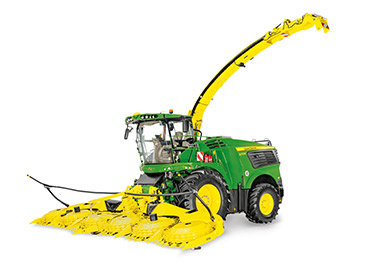
John Deere Harvester SP |
“John Deere expanded the horsepower offerings for our wide-body forage harvesters that include the 9500 to 9900 models to provide improved performance and made updates to maximize machine uptime and reduce cost of operation,” says Chase Milem, marketing manager with John Deere.
The 9500 (755 max hp), 9600 (775 max hp) and 9700 (813 max hp) feature the new John Deere Power Systems JD18X, 18L engine. The new engine provides market-leading productivity with up to 13% higher efficiency. The diesel-only innovation does not require DEF fluid.
The JD18X features a 750-hour service interval — an improvement of 33% compared to the previously used 13.5L engine. Since no DEF fluid is required, ownership costs are kept low, and machine reliability is increased. For customers with higher horsepower requirements, John Deere still offers the 9800 (855 max hp) and 9900 (956 max hp) models equipped with the Liebherr 24L engine.
“The ideal performance characteristics of the John Deere engine decrease fuel consumption and are perfectly aligned and synchronized for outstanding crop flow through the machine,” Milem says. “This is partly due to our industry exclusive HarvestMotion™ Plus engine technology. HarvestMotion Plus provides a unique torque-rise curve and extra power at low engine rpm, which increase power so operators can push through tough conditions while maintaining crop-harvesting quality.”
In addition, each 9000 Series comes equipped with a new spout that provides better operator visibility while unloading and boosts machine reliability compared to previous models. Thanks to the addition of more clean-outs and a change in the geometry of the spout, customers can run in “sticky” crop conditions for longer periods of time without plugging. This helps make the forage harvester easier to load while providing more comfort to the operator than previous models.
“Contractors and custom harvesters will appreciate the constant maximum throughput these forage harvesters provide, along with a cab that features enhanced operator visibility and comfort,” Milem says. “Reliability, low cost of operation, increased quality of completed work, minimized daily maintenance requirements and reduced total fluid consumption were key improvements John Deere made that will benefit customers.”
One way dairy and livestock operations can take full advantage of the improved forage quality and kernel processing of the 9000 Series is by using John Deere Premium or XStream KP™ kernel processors.
“Each delivers exceptional corn silage processing scores regardless of cut length,” Milem says.
John Deere offers integrated technology for self-propelled forage harvesters, with fully integrated AutoTrac™ RowSense™ guidance, Active Fill Control with rear unloading, and the Generation 4 Universal Display.
“These are industry-leading features that are available as options from the factory,” Milem says.
Another option Milem highlighted is John Deere HarvestLab™ 3000, which provides on-the-go constituent sensing and documentation.
“Customers have told us for years how much they appreciate the versatility of HarvestLab 3000,” Milem says. “It can be used as a manure sensing tool and as a stand-alone stationary test unit that can analyze up to seven constituents. These constituents include NDF (neutral detergent fiber), crude protein, moisture, sugar, starch, crude fiber, ash and ADF (acid detergent fiber). Using the documented information, farmers can quickly analyze data from worked fields, adjust fertilizer use, select optimal varieties for the upcoming season, and improve water management.”
When it comes to staying connected to their forage harvesters, Milem said John Deere makes it easy by including JDLink™ hardware in base equipment on the 9000 Series and the ability to turn on the JDLink Connection in John Deere Operations Center™ for free. A JDLink connection allows field and machine data from the cab to be sent wirelessly to Operations Center. The Operations Center mobile app gives access to that field and machine data from anywhere, anytime. Custom harvesters can set up work plans before harvesting and send them wirelessly to the Gen 4 display in the cab, monitor harvest progress, and analyze results and machine data. Having access to this data can support operators, saving owners time and money.
For more information on Deere & Company, visit www.deere.com/en/news/.
Industry’s first autonomous spreader debuts
Case IH and Raven Industries introduce the agriculture industry’s first autonomous spreader: the Case IH Trident™ 5550 applicator with Raven Autonomy™. This innovative solution delivers on customers’ demands for autonomous equipment to help solve labor challenges and increase productivity on their operations.
“This is a significant milestone in our accelerated product development efforts between Case IH and Raven, highlighting our intense collaboration and robust product innovation following CNH Industrial’s acquisition of Raven in late 2021,” says Scott Harris, Case IH global brand president.
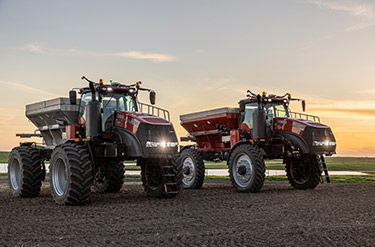
The Case IH Trident™ 5550 applicator with Raven Autonomy™ allows for one or more driverless machines in the field. |
The Case IH Trident 5550 applicator with Raven Autonomy combines proven driverless technology with an agronomically designed spreading platform for a flexible autonomous solution. The technology stack is powered by guidance and steering, propulsion control, perception and path-planning software developed by Raven.
“The core of today’s ag tech is rooted in Raven’s customer-centric approach: simplifying farming processes to gain tremendous efficiencies,” says Eric Shuman, Raven general manager. “This integrated solution empowers customers to make their operations even more efficient, encouraging them to thoughtfully adopt increasing levels of automation and autonomy.”
From a mobile device, operators can plan and complete an entire field operation based on mapped field boundaries. The Raven Autonomy perception system, through a series of advanced cameras and radar system, is constantly sensing a 360° environment around the machine for obstacles and motion initiation while operating. With artificial intelligence, Raven’s perception controller processes the continuous stream of images, which interprets and detects obstacles. The remote operator can view the cameras through the mobile device at any time.
If an obstacle is detected, the machine will safely come to a stop and an alert will pop up on the mobile device. From there, the operator can evaluate the situation and determine the next course of action. A variety of machine tasks and functions can be viewed remotely through the mobile device, including but not limited to fuel level, Diesel Exhaust Fluid level, speed, rpm, bin-level status, Universal Terminal information and diagnostic trouble codes.
This first-to-the-market innovation comes as a result of ongoing research following the Case IH autonomous concept vehicle launch in 2016 about the desire for and priority of autonomous technologies. Findings concluded that spreading is among the most utilized autonomous tasks that customers would adopt.
The Case IH Trident 5550 applicator with Raven Autonomy will be operating in the North American market with limited availability in 2023.
For more information, visit https://info.caseih.com/CIHAutonomy.html and www.ravenind.com.

